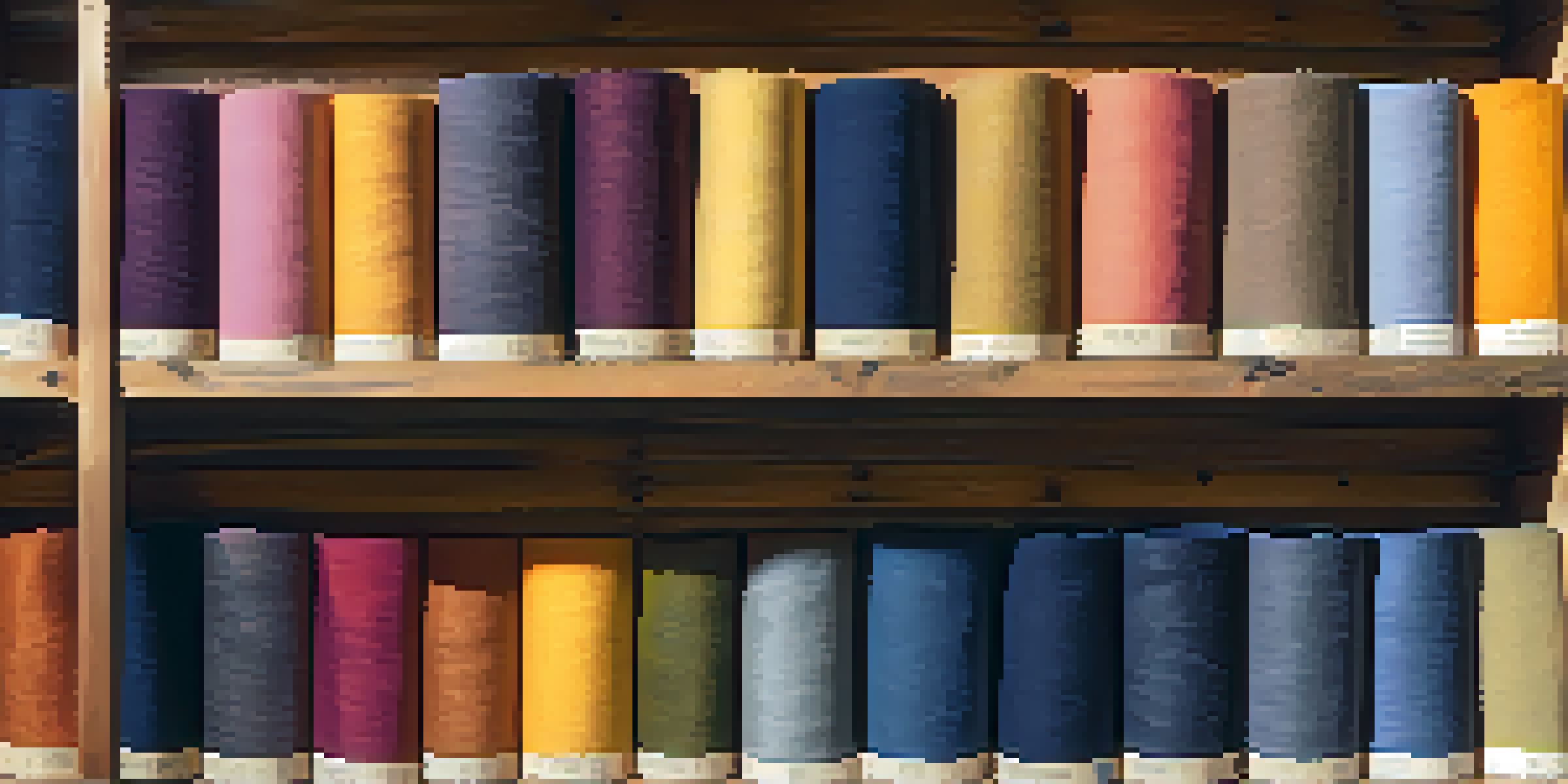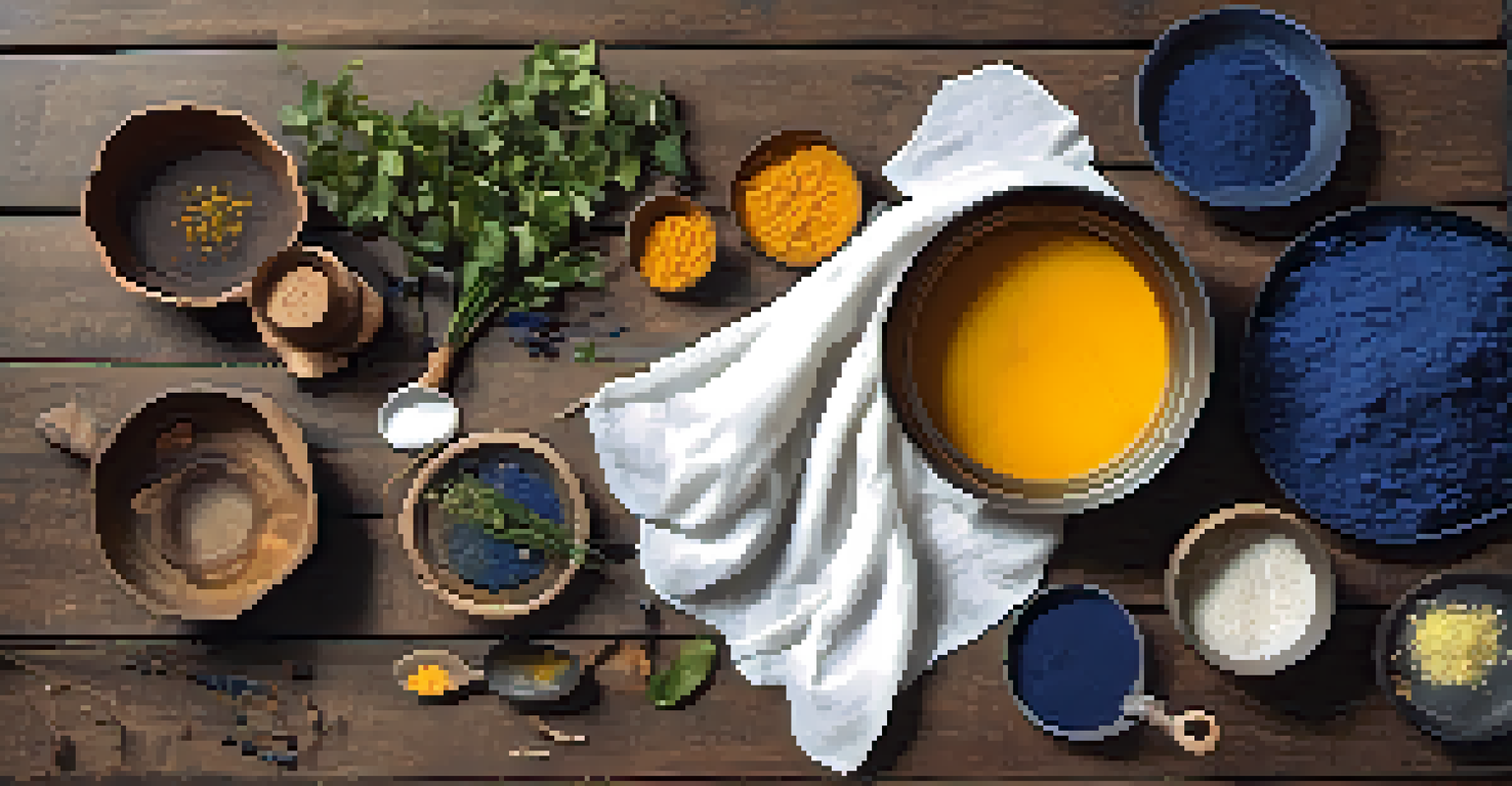Plant-Dyed Fabrics: A Natural Approach to Eco-Friendly Fashion

Understanding Plant-Dyed Fabrics and Their Origins
Plant-dyed fabrics are textiles that derive their colors from natural plant sources, such as roots, leaves, and fruits. This age-old technique harks back to ancient civilizations where people used their surroundings to create vibrant hues. Unlike synthetic dyes, which can be harmful to the environment, plant-based dyes offer a sustainable alternative that honors tradition and craftsmanship.
The earth is what we all have in common.
By using plants like indigo for deep blues or madder root for reds, artisans create stunning fabrics that not only look beautiful but are also biodegradable. This natural approach to dyeing allows for a wide range of colors and shades, each with its unique story. The revival of this technique reflects a growing interest in sustainable practices in the fashion industry.
Moreover, the process of creating plant-dyed fabrics fosters a deep connection between the artisan and the materials. Each dyeing process can vary based on the season, the plant's condition, and the dyeing method, resulting in unique pieces that celebrate individuality and creativity.
The Environmental Benefits of Plant-Dyed Fabrics
One of the most compelling reasons to embrace plant-dyed fabrics is their minimal environmental impact. Conventional synthetic dyes often contain toxic chemicals that can pollute waterways and harm wildlife. In contrast, plant-based dyes are generally non-toxic and can be safely disposed of, making them a more eco-friendly choice.

Using renewable resources like plants for dyeing means that these fabrics are often produced with less water and energy compared to their synthetic counterparts. Additionally, many plant dyers source their materials locally, reducing the carbon footprint associated with transportation. This closed-loop approach aligns beautifully with the principles of sustainable fashion.
Sustainability through Plant Dyes
Plant-dyed fabrics offer an eco-friendly alternative to synthetic dyes, promoting sustainable practices in the fashion industry.
Furthermore, plant-dyed fabrics contribute to biodiversity. By cultivating a variety of dye plants, farmers can promote ecological balance and support sustainable agriculture. This not only benefits the environment but also helps preserve traditional farming methods that might otherwise fade away.
Exploring Popular Plants Used for Dyeing Fabrics
There’s a fascinating variety of plants that can be used for dyeing fabrics, each offering a distinct palette of colors. For example, turmeric produces a vibrant yellow, while hibiscus can yield stunning shades of pink and red. These plants are often chosen not just for their color but for their availability and ease of use.
Sustainability is no longer about doing less harm. It’s about doing more good.
Indigo, renowned for its rich blue tones, has a long history in many cultures around the world. It’s a unique dye that undergoes a fermentation process, resulting in deep, complex hues that shift with each application. This transformative aspect of indigo dyeing is part of what makes it a favorite among textile artists.
Other noteworthy plants include onion skins for a warm orange and walnut hulls for deep browns. Each dyeing process is an adventure, as the colors can vary based on many factors, such as water temperature, fabric type, and even the time of year. This variability adds a magical element to the creation of plant-dyed fabrics.
The Process of Creating Plant-Dyed Fabrics
Creating plant-dyed fabrics is as much an art as it is a science. The process typically begins with sourcing the dye plants, which can be purchased from suppliers or harvested directly from nature. Once collected, the plants are prepared, often by chopping or grinding them to release their color pigments.
The next step involves boiling the plant matter in water to extract the dye. This mixture is then strained, leaving behind a vibrant dye bath ready for the fabric. Before dyeing, the fabric usually undergoes a mordanting process, where it is treated with a substance that helps the dye bond to the fibers, ensuring vibrant, lasting colors.
Unique Colors from Natural Sources
Each plant used for dyeing provides distinct hues and qualities, resulting in one-of-a-kind textiles that celebrate individuality.
Finally, the fabric is submerged in the dye bath and left to soak until the desired color is achieved. Afterward, it is rinsed, dried, and often washed again to set the color. This whole process can take several hours or even days, depending on the complexity of the dye, but the result is a beautifully dyed fabric that tells a story of its origins.
Why Choose Plant-Dyed Fabrics for Fashion
Choosing plant-dyed fabrics is not just a fashion statement; it's a choice that reflects values of sustainability and ethics. By opting for these eco-friendly materials, consumers support artisans and small-scale producers who are committed to preserving traditional techniques. This support helps keep these age-old practices alive in a modern world dominated by mass production.
Moreover, plant-dyed fabrics often exhibit unique color variations and textures that cannot be replicated with synthetic dyes. Each piece becomes one-of-a-kind, allowing wearers to express their individuality. This uniqueness is what many fashion enthusiasts are looking for, as they move away from cookie-cutter clothing.
In addition, as the demand for sustainable fashion grows, more brands are recognizing the appeal of plant-dyed fabrics. This trend not only helps reduce the environmental impact of the fashion industry but also encourages innovation and creativity in design. By choosing plant-dyed options, consumers can be part of a larger movement towards a more sustainable future.
Caring for Plant-Dyed Fabrics
Caring for plant-dyed fabrics is essential to maintain their beauty and longevity. Generally, these fabrics should be washed in cold water with mild detergent to avoid fading. Since they are dyed with natural materials, they can be more sensitive to harsh chemicals and high temperatures.
It's also a good idea to avoid prolonged exposure to direct sunlight, as this can lead to color fading over time. When drying, hang them in a shaded area to preserve their vibrant hues. Additionally, storing plant-dyed fabrics away from direct light can help maintain their colors for years to come.
Caring for Plant-Dyed Fabrics
Proper care of plant-dyed fabrics enhances their longevity, emphasizing the importance of mending and preserving these unique garments.
For those who want to extend the life of their plant-dyed clothes, mending and repairing become part of the story. Rather than discarding a worn-out piece, consider patching it or turning it into something new. This not only reduces waste but also adds character to the garment, further emphasizing the beauty of sustainable fashion.
The Future of Plant-Dyed Fabrics in Fashion
As consumers become increasingly conscious of their environmental footprint, the future of plant-dyed fabrics looks bright. Many designers and brands are integrating these sustainable options into their collections, recognizing that eco-friendly practices resonate with a growing audience. This shift towards sustainability is not just a trend; it's becoming a fundamental aspect of fashion.
Innovations in dyeing techniques and the development of new plant-based colors are helping to expand the possibilities of plant-dyed fabrics. Collaborations between textile artists and fashion designers are pushing the boundaries of how these materials can be used, resulting in stunning, contemporary designs that appeal to modern consumers.

Ultimately, the future of plant-dyed fabrics is about more than aesthetics; it's about creating a connection between fashion, nature, and ethical practices. By embracing these textiles, we can support a movement that values sustainability, creativity, and respect for the planet, paving the way for a more eco-conscious fashion industry.